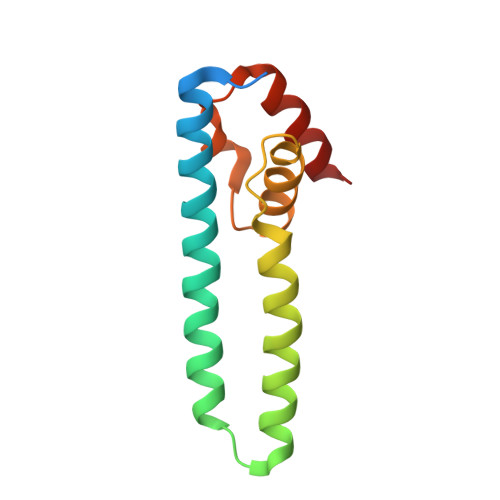Additional families of orange carotenoid proteins in the photoprotective system of cyanobacteria.
Bao, H., Melnicki, M.R., Pawlowski, E.G., Sutter, M., Agostoni, M., Lechno-Yossef, S., Cai, F., Montgomery, B.L., Kerfeld, C.A.(2017) Nat Plants 3: 17089-17089
- PubMed: 28692021
- DOI: https://doi.org/10.1038/nplants.2017.89
- Primary Citation of Related Structures:
5TZ0 - PubMed Abstract:
The orange carotenoid protein (OCP) is a structurally and functionally modular photoactive protein involved in cyanobacterial photoprotection. Using phylogenomic analysis, we have revealed two new paralogous OCP families, each distributed among taxonomically diverse cyanobacterial genomes. Based on bioinformatic properties and phylogenetic relationships, we named the new families OCP2 and OCPx to distinguish them from the canonical OCP that has been well characterized in Synechocystis, denoted hereafter as OCP1. We report the first characterization of a carotenoprotein photoprotective system in the chromatically acclimating cyanobacterium Tolypothrix sp. PCC 7601, which encodes both OCP1 and OCP2 as well as the regulatory fluorescence recovery protein (FRP). OCP2 expression could only be detected in cultures grown under high irradiance, surpassing expression levels of OCP1, which appears to be constitutive; under low irradiance, OCP2 expression was only detectable in a Tolypothrix mutant lacking the RcaE photoreceptor required for complementary chromatic acclimation. In vitro studies show that Tolypothrix OCP1 is functionally equivalent to Synechocystis OCP1, including its regulation by Tolypothrix FRP, which we show is structurally similar to the dimeric form of Synechocystis FRP. In contrast, Tolypothrix OCP2 shows both faster photoconversion and faster back-conversion, lack of regulation by the FRP, a different oligomeric state (monomer compared to dimer for OCP1) and lower fluorescence quenching of the phycobilisome. Collectively, these findings support our hypothesis that the OCP2 is relatively primitive. The OCP2 is transcriptionally regulated and may have evolved to respond to distinct photoprotective needs under particular environmental conditions such as high irradiance of a particular light quality, whereas the OCP1 is constitutively expressed and is regulated at the post-translational level by FRP and/or oligomerization.
- MSU-DOE Plant Research Laboratory, Michigan State University, East Lansing, Michigan 48824, USA.
Organizational Affiliation:
















